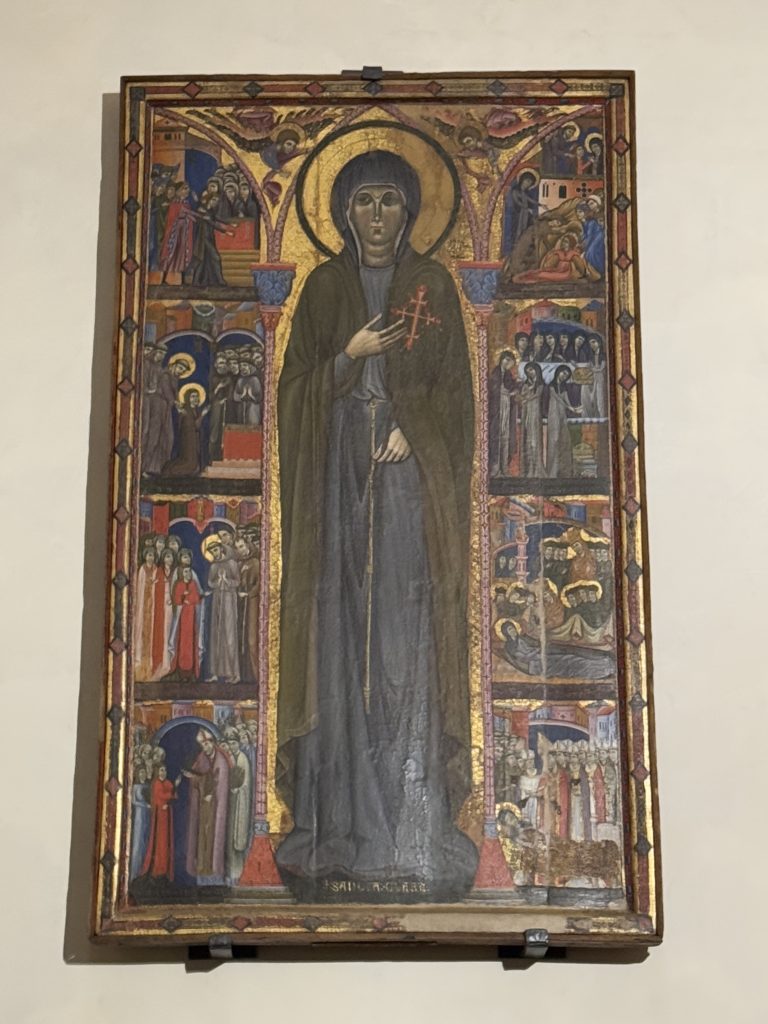Clare of Assisi
Foundress of a 13th Century Monastic Order
Saint Clare was the foundress of the Order of the Poor Clares, and her inspiring story is deeply connected with Francis of Assisi, creator of the Franciscan Order who lived a life of poverty and care for all living things. Clare is remembered as a woman of extreme piety and poverty, of spiritual leadership, of having great friendship and spiritual influence on Francis, and of saving her monastery and the city of Assisi from a Saracen attack by courageously holding the Host of the Eucharist in front of the attackers.



Biography: Clare was born into a wealthy family and expected to marry well. In 1212, when Clare was eighteen, she heard Francis preach and was so moved she arranged to meet with him privately and ask for his help with her decision to live a life worthy of the gospel and commit to a cloistered life. Francis immediately recognized God’s calling on Clare’s life. On Palm Sunday, she left home in the dark of night to meet Francis at St. Mary of the Angels and take her vows. Clare discarded her expensive clothes at the altar and her hair was shorn in an act of tonsure to represent her devotion to Christ as His bride. She was sent to stay at a Benedictine convent, but Clare’s family and angry suitors discovered her location and physically attempted to drag her away. Clare remained steadfast.
Francis desired to establish a convent in Assisi and persuaded Clare to found it, although she was adamant she did not want to lead, he eventually succeeded in installing her as abbess. Clare and her sisters lived in extreme poverty which alarmed even the Pope! They went barefoot, slept on hard ground, and survived only on charity. The extent of her austerity threatened her health. She petitioned continuously for Papal approval of her Rule of Poverty, and in 1253 was granted her request with the seal of Pope Innocent IV.
Clare was canonized only two years after her death. She was not martyred, but her extreme piety and ability to rescue her town from invaders (near martyrdom) quickly propelled her saintly status. In art, she is often portrayed with other martyred saints to elevate her sanctity by association. Later images propose she was venerated in plague protection, as there were stories that she cured neck fistulas of her monastery sisters. Clare is most commonly painted holding a Host container to reflect her selfless act of resistance in the face of grave danger, and her unwavering confidence in the power of the Body of Christ.
Resources:
- “Brochure of San Damiano,” n.d. www.santuariosandamiano.org.
- Clare, Thomas. The Life of Saint Clare: Ascribed to Fr. Thomas of Celano of the Order of … The Dolphin Press, 1910. http://archive.org/details/lifesaintclarea00robigoog.
- Ellsberg, Robert. All Saints: Daily Reflections on Saints, Prophets, and Witnesses of Our Time. Crossroads, NY: Crossroad Publishing Company, 1955.
- Jameson, Anna. Legends of the Monastic Orders as Represented in the Fine Arts: Forming the Second Series of Sacred and Legendary Art. London, Longmans, Green, 1890. http://archive.org/details/LegendsOfTheMonasticOrders.
- One Hundred Saints: Their Lives and Likenesses Drawn from Butler’s “Lives of the Saints” and Great Works of Western Art. New York: Bulfinch Press, 1993.
- “The Story of the San Damiano Crucifix, Know Your Faith: Monastery Icons.” Accessed March 21, 2025. https://www.monasteryicons.com
- St Francis of Assisi. “The San Damiano Cross.” Accessed March 21, 2025. https://www.stfoafrisco.org/sandamiano.a/.
